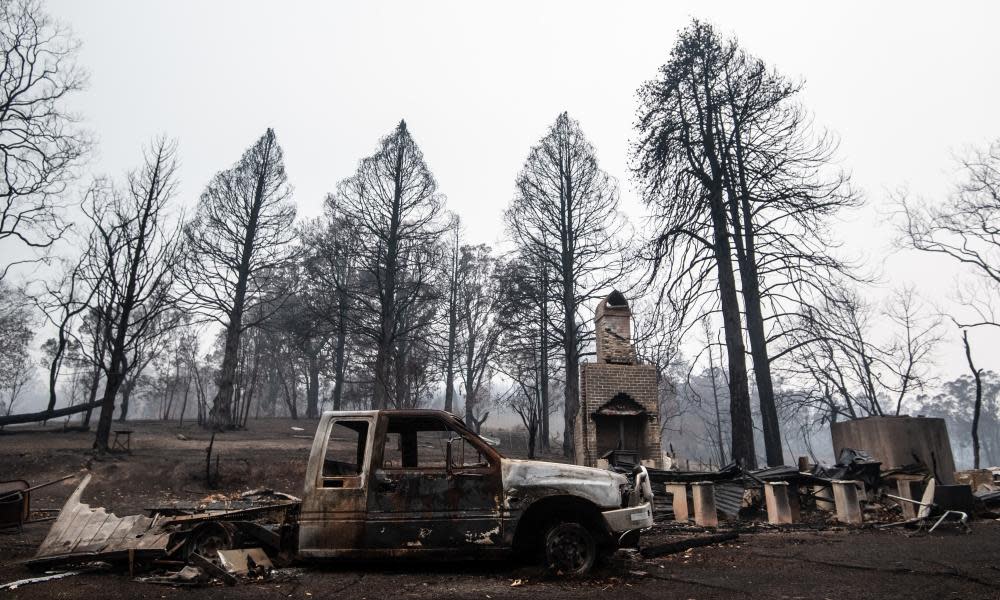Bushfire-destroyed homes should not be rebuilt in riskiest areas, experts say

State governments have been warned against promising to recreate some communities destroyed by the bushfire crisis and urged to consider preventing homeowners from rebuilding their homes in the riskiest areas.
Three planning experts, including two who appeared on a planning panel convened for the Victorian Black Saturday royal commission, told Guardian Australia to avoid repeating what they considered the mistakes of past bushfire recoveries.
They called for state governments to buy back land from people in the most bushfire-prone areas, as occurred after Black Saturday and raised particular concerns about rebuilding in isolated homes and towns, particularly those where there was “one road in and one road out” and those in heavily timbered environments.
“If we keep locating people out in these high-risk areas, more property damage is going to be experienced and more lives are going to be lost,” said planning expert Prof Michael Buxton, who gave evidence at the 2009 royal commission.
Authorities in Victoria said at least 350 homes had fires that have ravaged the south-east, while the figures in New South Wales now stands at more than 1,500. 28 people have also been killed since October, including 20 in NSW and five in Victoria.
Related: Australian bushfires from the air: before and after images show scale of devastation
Both the Victorian premier, Daniel Andrews, and NSW’s Gladys Berejiklian have promised to rebuild devastated communities and unfurled significant funding packages to support them. However, Victoria’s immediate promise to rebuild one local primary school drew some criticism from the local fire captain, who claimed it would be all but impossible to defend in a future fire.
Roz Hansen, who also appeared as a planning expert at the royal commission, told Guardian Australia she remained concerned that people would rebuild in dangerous areas.
“With some of the places that have been affected by bushfires, the geography of the place is such that the fire will come to the ridge line and then sweep down the valley and then really, there’s nothing you can do to stop it,” she said.
“In those situations, people who are in settlements or in locations where that’s the geography of their immediate environment and they only had one road, to me, that’s a death trap.”
Buxton said the 2009 royal commission indicated that in some cases, due to topography, access and climate change, the risk could not be reduced to an acceptable level.
“So if those homes burn down, why would any responsible government allow them to be rebuilt,” he said.
A number of communities across NSW and Victoria have been cut off at the height of fires that have ravaged both states in the new year. Thousands have been evacuated in towns where authorities have said they will not be able to protect them.
Prof Alan March of the University of Melbourne, told Guardian Australia he was certain there would be homes that authorities will later rule cannot be rebuilt.
Related: Bushfire-ravaged communities return to ruins – in pictures
“I’m sure there will be some areas where that will be the case, particularly remote locations or locations on extreme slopes next to extensive areas of bushland and forest,” he said.
March, as well as Buxton and Hansen, declined to name any specific areas where they believed homeowners or local authorities should not rebuild.
But he said government should consider relocating public facilities, roads, and realigning lots and boundaries and the like.
Buxton pointed the example of Wye River in Victoria, which was rebuilt after devastating fires in 2015, as one he hoped the government did not repeat.
“If there was area that should not have been allowed to be rebuilt it was that,” Buxton told Guardian Australia.
“The government could have actually spent that amount of money [on work to allow for the rebuild] just buying back the land because the house was covered by insurance.”
Hansen said she remained concerned about Marysville, a town in Victoria’s Yarra Valley she told the royal commission should not have been rebuilt after Black Saturday.
She said any buyback scheme should be voluntary, but in cases where people wanted to rebuild, “the requirements should be very stringent”. “I’ve even said that in some cases, it should be mandatory that they have bunkers in that particular settlement.”
The owners of 198 properties applied for the scheme and 138 were deemed to be eligible. Of the 138, 116 have settled or are about to settle with the government.
After more than 2,000 homes were lost during the fires, the Victorian government said its buyback scheme cost $25.6m to buy 116 homes. About 200 applied, but not all were eligible as the homes needed to be within 100 metres of ‘‘significant forest’’.
March acknowledged that such schemes were expensive for the government and challenging for local communities, who would take years to come to terms with their loss.
“It’s not a simple process because it requires people to engage with formal systems they might not be ready to engage with when they’re suffering from the effects of a bushfire,” he said.


